Showdown in Nashville
The final fight for women’s votes occurred in Nashville, Tennessee, in August 1920.
The Tennessee State legislature, called into special session, was to vote on ratifying the 19th amendment to the constitution giving women the right to vote.
The amendment had been passed by Congress the year before. Under the U.S. Constitution, it needed to be approved by 36 of the existing 48 state legislatures. Thirty five states had approved it by the spring of 1920. Six states had rejected it.
Out of the remaining seven states left to vote, only Delaware and Tennessee seemed like possible yes votes. Although Tennessee legislators had just given the women of the state the right to vote in presidential and local elections, there was doubt they would pass the amendment.
Still the suffragists asked President Woodrow Wilson to put pressure on Tennessee Governor A.H. Roberts to call a special session. The governor, who was running for reelection against an opponent who supported women’s suffrage , decided to call a special session for August.
Anti against pro suffragists
Carrie Chapman Catt, the most prominent suffragist after the deaths of Susan B. Anthony and Elizabeth Cady Stanton, came to Nashville on July 17 and stayed in Tennessee until the vote was taken. She took a room at the Hermitage Hotel, across from the State Capitol. Josephine Pearson, the leader of the anti-suffrage movement in Tennessee, also came to Nashville and stayed at the Hermitage Hotel.
The battle between the two sides was bitter. Carrie Chapman Catt wrote “at least two Anti-suffrage men and one woman are here to pledge members against ratification. They will lie, misrepresent and appeal to all the sordid motives they may find… Please hasten now and report as fast as you can….We must “Trust in God, but keep our powder dry.”
At the anti-suffrage group, one woman wrote that her group consisted of “home-loving women of the South, who do not picket, card-index, or blackmail candidates.” Both groups sent representatives to the legislators’ homes to lobby for their votes.
When the legislators arrived in Nashville for the special session, they were met at the train station. Antis handed out red roses as their symbol, while the pros gave yellow roses. More and more people from both sides came to Nashville to lobby for their cause. Parades were held in downtown streets while garden parties were given to try and persuade the representatives.
"We can pray."
A fever of sorts gripped the participants. Carrie Chapman Catt was sure that her telephone was tapped by the Antis. Lobbyists were supposedly offering business loans, political appointments and out-right bribes. The suffragists set up all night patrols at the hotel and the train station to try and stop any departures by representatives supporting them.
There were so many rumors that neither side was sure they had enough votes to win. The night before the vote, Catt told her supporters there was only one more thing to do—“We can pray.”
The Senate had approved the amendment earlier. It was up to the House of Representatives on August 18. With the galleries packed, voting began. On a motion to table the amendment, meaning that the amendment would not be voted on, thus killing it, the vote was tied 48 to 48. They held another vote on tabling it and it was still tied.
Realizing that if the vote on the amendment itself was tied it could not be ratified, House Speaker Seth Walker, who was against the amendment, called for a vote. As the voting began, no one knew that one of the representatives, Harry Burn of Niota was struggling with how he should vote.
A letter from his mother
Burn had worn the red rose of the anti-suffragists, and had voted twice to table the amendment. But, in his pocket he had a letter from his mother. Read part of the letter by clicking here. His mother, Febb Burn, wrote:
Dear Son:
Hurrah and vote suffrage!...Don’t forget to be a good boy and help Mrs. Catt put the “rat” in ratification. Your Mother.
When Burn’s name was called, this time he quietly said “aye” or yes. At first, no one was sure what they had heard, but the crowd became more excited as the word was passed. At the end of the roll call, it was announced that the resolution carried, 49-47.
The galleries erupted with a roar. Walker changed his vote from no to yes, so he could try and bring it back up for a vote, so the final total was 50-46. Women were screaming, crying, and singing.
Legislators were hugging each other in the aisles. As the word spread, the pro-suffragists outside started celebrating. Carrie Chapman Catt, who was sitting in her hotel room waiting, heard the news through her window.
As the 36th state to ratify the amendment, and the last one needed to make it law, Tennessee was called the “perfect 36.” And women across the country celebrated the vote.
Read more about Tennessee suffragists leaders.
Picture Credits:
- Photograph of Carrie Chapman Catt. This photo was created sometime between 1909 and 1932. Chapman is shown talking on a telephone. Library of Congress.
- Photograph of Anti-suffragists at the Hermitage Hotel in Nashville in August 1920. Josephine A. Pearson and Mrs. James S. Pinkard are shown standing alongside a Confederate veteran headquarters. Pinkard is shown holding the Confederate flag. She was the president general of the Southern Women’s League for the Rejection of the Susan B. Anthony Amendment. Pearson is shown holding a smaller American flag and was president of the organization’s Tennessee Division. Tennessee State Library and Archives.
- Photograph showing Governor Thomas Rye signing State's Women Suffrage Bill. This photo was taken in 1919 and shows Governor Rye signing the suffrage bill. Standing behind Governor Rye are seven women, the Speaker of the Tennessee House of Representatives, William B. Cooper, and Speaker of the Tennessee Senate, Albert E. Hill. This bill allowed Tennessee women to vote in presidential and municipal elections, but not state ones. Tennessee State Museum Collection, 4.426.1.
- Photograph of Representative Harry T. Burn in 1919. Burn cast the deciding vote in the Tennessee state legislature to ratify the 19th Amendment to the U.S. Constitution. C. M. McClung Historical Collection, Knox County Public Library.
- Photograph of Febb E. Burn, mother of Rep. Harry T. Burn. Mrs. Burn is shown in her garden at Hathburn Farm in Niota, Tennessee. Rep. Burn’s deciding vote was influenced by the letter his mother wrote urging him to vote in favor of women’s suffrage. C. M. McClung Collection, Knox County Public Library.
- Two pages from the Febb Burn letter to her son, Rep. Harry Burn. It was the receipt of this letter that persuaded Burn to vote for the women's suffrage amendment. C. M. McClung Collection, Knox County Public Library
Confronting the Modern Era >> Life in Tennessee >> Getting a Fair Share >> Showdown in Nashville
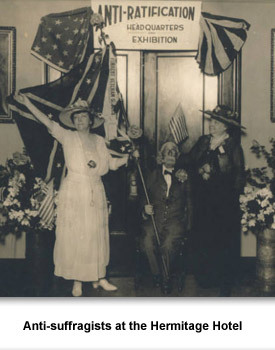
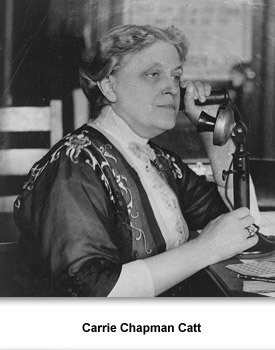
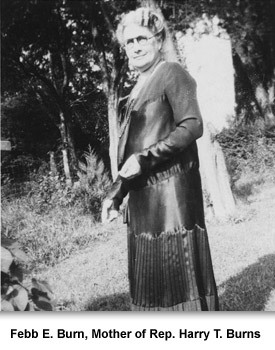
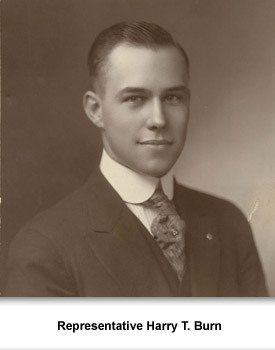
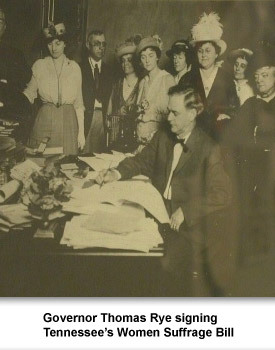
 Sponsored by: National Endowment for the Humanities
Sponsored by: National Endowment for the Humanities